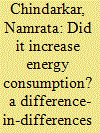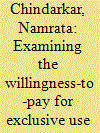| Srl | Item |
| 1 |
ID:
192806


|
|
|
|
|
| Summary/Abstract |
Electricity access is an important issue and building capacity for it requires drawing relevant lessons from past policies. In this study, we evaluate the effect of the Jyotigram Yojana, or the lighted village scheme, a supply-side policy intervention during 2003–08 to increase rural electricity access in Gujarat, India. We hypothesize that policy implementation is associated with increased electricity consumption. To test this hypothesis, we exploit variation in the timing of policy implementation at the village level, and use a generalized difference-in-differences strategy for identification. Further, we use night-time luminosity measured through remote sensing as a proxy for electricity consumption, and control for weather, village fixed effect, year fixed effect, and village or administrative block specific time trend. We find that while the overall effect of the policy on night-time luminosity was not statistically significant, the effects were likely heterogeneous, with the night-time luminosity increasing in some districts after policy implementation and decreasing in others. We conclude that the policy might have had a re-distributive effect on electricity access or consumption and recommend adopting a more holistic approach – incorporating both supply-side and demand-side measures – to increase electricity access.
|
|
|
|
|
|
|
|
|
|
|
|
|
|
|
|
| 2 |
ID:
177404


|
|
|
|
|
| Summary/Abstract |
Using unique household-level data from rural areas of six energy-access-deprived states in India, we examine the willingness-to-pay (WTP) for exclusive use of liquefied petroleum gas (LPG) for cooking. We find that awareness about LPG's health benefits and diffusion of LPG within the community are the strongest determinants of WTP for exclusive use of LPG. Among demographic characteristics, only household size is correlated with WTP. Importantly, households exhibit significant price elasticity with regards to exclusive use of LPG. Households with irregular cash flows are less likely to pay for exclusive use of LPG. We find limited evidence supporting a negative association between availability of free biomass and the WTP for exclusive use of LPG. In contrast, higher household expenditure on purchased biomass is positively associated with WTP. Our estimates of mean WTP suggest that they are higher than the current effective monthly cost of subsidized LPG across households. However, they mask variation, and disaggregated estimates suggest that about 40–45 per cent of the households not using LPG as their primary fuel have a lower WTP than the current effective monthly cost of subsidized LPG and hence would need additional support to enable their cooking energy transition.
|
|
|
|
|
|
|
|
|
|
|
|
|
|
|
|